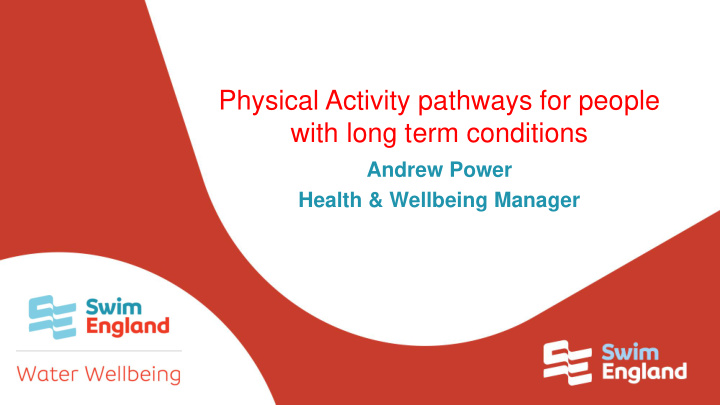



Physical Activity pathways for people with long term conditions Andrew Power Health & Wellbeing Manager
Swim England: Towards a nation swimming Vision A nation swimming Mission Creating a happier, healthier and more successful nation through swimming
Swimming and Health Commission Report • Reviewed and scrutinised the available evidence on the benefits of swimming for individuals, patients, communities and nations • Systematic reviews on the health and wellbeing benefits across the lifespan, highlighting disparities in the evidence practice and access • Highlighted the many health advantages that regular swimming provides Outputs • Academic report and summary document • Infographics with key messages Website: bit.ly/HealthBenefitsofSwimming
ANTI-HYPERTENSIVE PROPERTIES Reduction in BP in hypertensives of varying severity Improvements in vascular function (carotid artery compliance, • Water is a supportive flow mediated dilatation, & cardiovagal baroreflex activity) environment, enabling participants to meet the Bartels et al (2016) Chen et al (2010) Laurent et al (2009) aerobic, strength and balance Igarashi & Nogami (2018) components of the CMO physical activity guidelines. • Water is a particularly conducive environment for LIPID & GLYCAEMIC PROFILE people with long term Augmented atrial pressure in immersion causes conditions to exercise. hormonal/neural adjustments suppressing RAAS. Superiority to land based exercise Lazar et al (2013) Delevatti et al (2015) Igarashi & Nogami (2018a)
How to improve ‘experience’ (outcomes)
What we know… People with health conditions exercise less than those without. They also swim less frequently. They tend to be less able swimmers. There are various important motivations to swim more, with health being top - but poor health is a barrier to swimming, affecting confidence. Swimming is the favoured activity, with or without health conditions.
Review site opportunities and action plan Delivery of training on inclusive customer experience for all facility staff Environmental Audit of site and improvement action planning Exercise Learn to Pool Pods Good Boost Referral Swim Online Guide to Pool pod Equipment Good Boost Exercise teaching AAFH training for Marketing training and access training and people with Training Cards swim Materials and to software support health teachers manual conditions Ongoing support from Swim England on recruitment/marketing and training, webinars, etc Data collection and share and learn days
LMCT Pool Pods “Lifts and hoists can often be cumbersome and even off-putting for those wanting to get into the water independently and with minimum fuss .” • Provides Fast, Dignified and independent access. • Easily maintained and moved off poolside • 20 pools (5 in London) • Sites must incorporate key elements of the Water Wellbeing model
Referred pathway Patient is identified with a long term health condition Risk stratification and needs identified - Signpost to appropriate activity Other activity Aquatic Activity e.g. Gym, health walks Exercise Adult Learn to Good Boost Referral Swim
Adult Learn to Swim Framework Four Adult Learn to Swim Awards 1.Be Water Confident 2.Be a Swimmer 3.Be a Better Swimmer 4.Be a Master Swimmer
Good Boost system BARRIERS TO LAND EXERCISE LIMITED PAIN FUNCTION FEAR MULTI- MORBIDITY
Good Boost system RECOMMENDATION REPEAT ASSESSMENT
Water Wellbeing support • Site and local area audits • Aquatic action planning • Development of the workforce • Environmental assessment • Review and adaptation of exercise referral programmes to incorporate aquatic elements • Tailoring ‘Learn to Swim’ offers • Implementation of ‘Good Boost’ aquatic rehabilitation system • Marketing & recruitment support • Resources to support delivery • Data collection & centralised evaluation
Contact Andrew Power - Health and Wellbeing Manager; andrew.power@swimming.org 07990 844 964
Recommend
More recommend